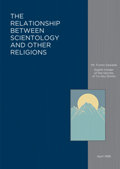Scientology has an obvious similarity with Buddhism. So much so that Mr. Hubbard once asked the question of Buddhist leaders in Asia if it were possible that he was the Metteya who had been prophesied by Buddha. Buddha, Guatama Siddhartha, had told his followers when he was about to die that in the future a Buddha would come to complete the job he had begun, and that he was to be known as Metteya. If Mr. Hubbard is to complete the humane intentions of the great Siddhartha, only time will tell. It is not the purpose of this paper to answer the question that Mr. Hubbard raised. However, the fulfilling of prophesies is another similarity to other religions, great and small.
The first book that this writer read was Scientology: The Fundamentals of Thought. In reading this book, this writer immediately thought of how similar the contents were to Shinto religions. Specifically there is the understanding that life is but an apparency, and that the physical world is actually the apparent world, there to be seen by the senses. This is very similar to the teachings of the founder of Seicho-no-Ie, Master Masaharu Taniguchi. (Master Taniguchi was one of the four people to write down the Story of The Universe for Holy Master Onisaburo Deguchi of Oomoto, another Shinto religion of Japan.) Both Oomoto and Seicho-no-Ie are relatively recent in Japanese history with Oomoto beginning at the end of the last century and Seicho-no-Ie beginning in the 1920s.
In Buddhism, this same idea of the “apparency of life” is expressed as “Shiki soku, Ku soku ze shiki” which means simply that anything that can be perceived with the five senses is simply nothingness or empty. The Buddhists also maintain that the universes of man are only manifestations of the mind. Of course Buddhism also has a much deeper meaning, as does Scientology.
Other explanations about life and the mind are also comparable to some Shinto beliefs, such as that the memories of experience are recorded in a film-like memory, each frame duplicating the events for the person. This again has similarities to Seicho-no-Ie. But one term in Scientology that was of great interest is the term theta. In Yui Itsu Shinto, what could be a corresponding term means “The Great Life Force of the Universe.” It is also in common with Hakke Shinto, which had been in charge of religious services for the Imperial Household until the time of the Meiji Restoration. This same concept then became the basis of newer Shinto religions such as Mahikari, which boomed after the war.
The concept of a person having lived before is old and fully accepted by Eastern religions. Scientology theory and practice is based around this concept, that one is a spiritual being which Mr. Hubbard has called a thetan, and that one can recall his past lives, and that as a spiritual being his actions of his past determine his situation in the present.
The concept of a person having lived before is old and fully accepted by Eastern religions. Scientology theory and practice is based around this concept, that one is a spiritual being which Mr. Hubbard has called a thetan, and that one can recall his past lives, and that as a spiritual being his actions of his past determine his situation in the present. There are more than 180,000 religious bodies in Japan, and I would expect that this concept is shared by most of them in one way or another. Of course this concept dates back not only to the time of Buddha, but also to the Veda, the source of the great Indian religions.





























